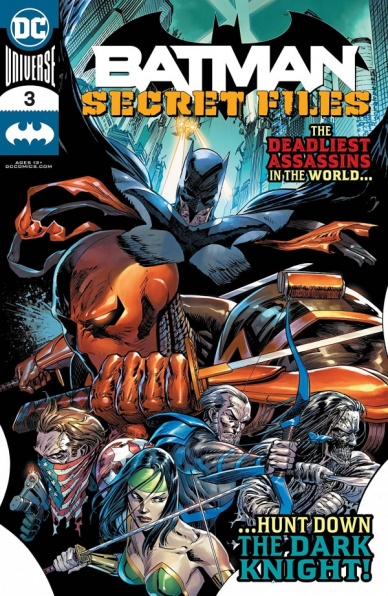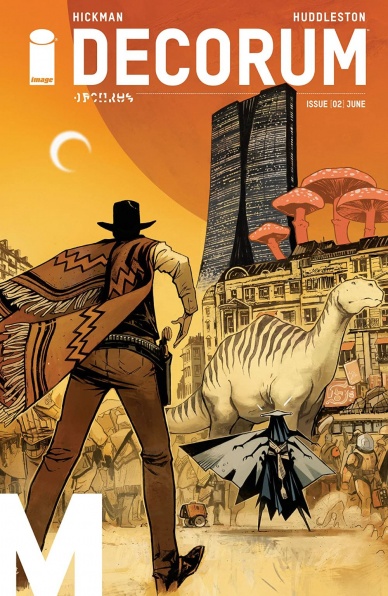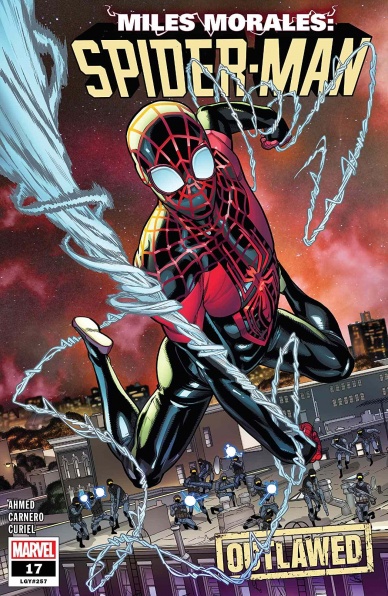There’s a lot to cover on Wednesdays. We should know, as collectively, we read an insane amount of comics. Even with a large review staff, it’s hard to get to everything. With that in mind, we’re back with Wrapping Wednesday, where we look at some of the books we missed in what was another great week of comics.
Let’s get this party started.

Written by Vita Ayala, Phillip Kennedy Johnson, Mariko Tamaki, Dan Watters, James Tynion IV
Illustrated by Andie Tong, Victor Ibanez, Riley Rossmo, John Paul Leon, Sumit Kumar
Lettered by Rob Leigh, Troy Peteri, Tom Napolitano, Deron Bennett, Carlos M. Mangual
Colored by Alejandro Sanchez, Jordie Bellaire, Ivan Plascencia, John Paul Leon, FCO Plascencia
Reviewed by Michael Govan
“Batman Secret Files” #3 isn’t a typical comic book. Instead of one story, the issue is broken up into five shorter stories. Each ‘vignette’ puts the Batman up against a different deadly villain. Overall, none of the stories were bad but mostly fall in the ‘just okay’ range. This comic had both its high notes and low notes.
One low note, for example – the dialogue was rough in some spots. Batman’s a noir-inspired character so it makes sense that his inner monologue would sound ‘noir’. Still, there were moments where it was a bit much. Bruce doesn’t always need to wax poetic about the nature of men and devils. Plus, I swear Batman’s already monologued about the ‘Scorpion and the Frog’ fable in another comic.
Another low note is, again, the stories are basically just ‘okay’. None of them are particularly memorable. I wish that some were given more room to breathe and could have used less of others. Cheshire’s ‘vignette’ is likely the pick of the litter and has solid characterization for both Cheshire and the Dark Knight. The Gunsmith story is likely my least favorite. While other shorts seek to give some insight into the featured villain, the Deathstroke vignette doesn’t even bother, only setting up the next event to be featured in the main title.
The art is solid for each story though. That’s definitely a high note. It’s interesting to see varied artistic depictions of the same character in the same issue. All different, all distinct and yet all Batman. Andie Tong and Victor Ibanez show Bruce as the traditionally broad-chested hero while Kumar and Rossmo on the other hand draw him with more exaggerated features. In Rossmo’s story, there are moments where Batman’s face is completely obscured in shadow which goes hand in hand with the horror nature of the story. Ibanez depicts a warmer Batman, joking with Green Arrow and cradling a young girl to safety. Through highs and lows, there’s still something for everybody.
Final Verdict: 6.5 – Five villains take their shot at the Bat in the okay “Batman Secret Files” #3.

Written by Jonathan Hickman
Illustrated by Mike Huddleston
Lettered by Rus Wooton
Reviewed by Matthew Blair
“Decorum” #2 is a comic that appears to be overwhelming. The heart of the series seems to be occupied by a very well-spoken and well-mannered assassin, but the book is so much more than that. In reality, the book jumps back and forth between different factions across a massive and incredibly busy universe that can appear confusing and daunting. And yet, somehow, the creative team makes it work.
“Decorum” #2 comes courtesy of writer Jonathan Hickman and, if you’ve ever read any of his previous work, you know that Hickman is a writer who enjoys discussing big ideas in big settings. The book is less of a continuous story and more of a collection of three stories broken up into four short chapters and bookended by the strange, yet revealing, exposition dump that Hickman loves to use in his writing. However, while the format doesn’t leave a lot of room for detail, it is well organized and tells a solid and effective story.
While the script provides the framework for the story, the real star of the show in “Decorum” #2 is the artwork. It’s shocking that the book lists Mike Huddleston as the sole artist because at first glance it looks like the book had three artists at once. The artwork changes with the requirements of the story, jumping from an abstract and aggressive style where people look more like shapes and squiggles, to highly realistic hand-drawn pencils that give a soft grey glow, to a more modern blend of manga and modern superhero art with heavily saturated colors. Again, like the writing, it can be difficult to grasp at first, but the book is well organized and it all makes sense after a while.
Continued below“Decorum” #2 is a book that forces the reader to pay attention and might be a bit daunting for new readers who aren’t used to how strange the medium of comics can be. Still, it’s a well organized and well-written book with some gorgeous artwork and a highly engaging and fascinating universe to play in.
Final Verdict: 8.7- It’s a bit difficult to follow if you’re not used to Hickman’s unique writing style and philosophy, but the artwork and worldbuilding are fascinating and wonderful to behold.

Written by Brian Azzarello
Illustrated and colored by Maria Llovet
Lettered by AndWorld Design
Reviewed by Kobi Bordoley
“Faithless II” #1 is your one-stop-shop for all your erotic occultist needs. The blood and kinky cybersex come included, free of charge. The bagged, alternate art NSFW covers? Those you might have to go out of the way for.
The story’s first installment saw the bored yet yearning artist Faith stumbles into a deal with the devil, and “Faithless II” #1 makes it clear that doing so comes with a price (duh). This title is firmly 18+, so if you don’t like your stories saucy, sexy, and spicy, feel free to move along.
Most of all, “Faithless II” is tight. Azzarello sets up Faith’s precariousness in the art world well and effectively shows her anxiety. Even without the Magic with a capital “M”, this would be a compelling story. Faith’s sultry demon lovers are just icing on the cake, giving the story heady undertones that mesh well with the abundant eroticism. The prose works even when Azzarello is not being coy, and he manages some fun scenes on the meaning of art that are unpretentious yet intellectual. This is good stuff!
But let’s be honest. If we’re talking about erotic comics, then art is really important. Thankfully, In “Faithless II” #1, Maria Llovet excels. To start, Llovet renders every character tastefully, giving each their fair share of composure and sensuality. Colorwise, the wide range of pinks, purples, and reds feel at the same time seductive and dangerous. The recurring image of a red door especially fits this profile.
It’s also worth mentioning that “Faithless II” #1 is incredibly readable even if you don’t have the full context of the first story installment. The plot makes sense, character motivations are clear, and relationships are clearly established. Azzarello and Llovet have set the scene for some devious fun and delicious chaos.
Final Verdict: 8.2. Anchored by strong aesthetic choices and clear direction, this story is an erotic romp worth indulging. Savor these panels.

Written by Adam Cesare
Illustrated by French Carlomagno
Colored by French Carlomagno
Lettered by Jim Campbell
Reviewed by Joe Skonce
Of all the stories to expand upon in the prequel to a prequel ‘Jim Henson’s The Dark Crystal: The Age of Resistance’ comic, it was surprising that one was about Hup, the Podling paladin. Hup was clearly the breakout character of the show, but it never felt important why he decided to don his spoon. Yet, ‘The Ballad of Hup and Barfinnious’ proved to be a wonderful look at the Podling’s origin. In “Jim Henson’s The Dark Crystal: The Age of Resistance” #8, Adam Cesare and French Carlomagno provide a delightful and satisfying conclusion to Hup’s first quest, highlighting the aspects that make him a hero.
Adam Cesare does a good job of adding some dimension to Hup. He’s brave, but his true strength lies in his kindness and cleverness. He is able to successfully deescalate the situation with the townsfolk and seedle, showing how the curious and gentle creature could not be responsible for the attacks using his wits. While Jim Campbell’s lettering shows that he is not being understood by the townsfolk, his friend Veara is able to relay his messages. But the highlight of the issue is his relationship to the con artist Barfinnious. Hup’s courage inspires the charlatan to help. Their final moments together show the bond the two have created, even if Barfinnious wasn’t always the hero Hup thought he was.
Continued belowThe dialogue is fun and charming and for the most part, French Carlomagno’s art feels right in line with the world of the Dark Crystal. This is best represented by the seedle, a giant creature covered in moss and mushrooms. It’s larger than life, but still has the look that it could be a practical puppet. He also does a good job of expressing emotions, but in a way that feels like it could be accurately translated to the screen, they’re not any more emotive than a puppeteer could do on set. The only real problem is that the colors are muted in “The Dark Crystal: The Age of Resistance” #8. Most of the backgrounds and settings are dark greys, which doesn’t match the lush and vibrant colors of the show. The only coloring that stood out was the seedle, but even then, it was lots of mossy greens. Nothing really popped, which felt like a missed opportunity.
Final Verdict: 7.1 “Jim Henson’s The Dark Crystal: The Age of Resistance” #8 is a fun romp that adds dimension to Hup. If only the colors matched the show.

Written by Saladin Ahmed
Illustrated by Carmen Carnero
Colored by David Curiel
Lettered by Cory Petit
Reviewed by Quinn Tassin
Saladin Ahmed is getting much much better at writing Miles Morales comic books. Up to this point, Ahmed’s work has been, at best, whelming, but with “Miles Morales: Spider-Man #17,” he’s started hitting most of the right notes. The issue gives us a nice little tour of Miles’s life in the “Outlawed” era of Marvel as he gives a bullied kid a pep talk, fights off some government agents that want to arrest him for being a teen, and just gets food with his family. The issue really succeeds on two fronts; the first, in being a good Spider-Man story that also feels specific to Miles as a character. It’s got all the classic Spider-Man elements but without falling into the trap of just writing Peter Parker in a biracial kid’s body (though it does suffer from some “how do you do, fellow kids?” energy). The second is its effective communication of the new status quo for teenage heroes in Marvel. The fact that Miles being a superhero is illegal now is baked into the issue in a way that feels natural and strong- especially that family discussion- as opposed to being forced and that’s not easy to do.
Carmen Carnero has proven herself a more than capable Spider-Man artist. More than anything, a great Spider-Penciler has to be able to capture the weird, hyper-flexible acrobatics of a Spider-Man and Carnero does that with gusto. The best part is how subtly mind-blowing her panel design is. She doesn’t use unheard of page layouts but her work still explodes off of the page in a way that feels unique from most artists. The fight between Miles and Dum Dum Dugan’s outfit is a standout in not only the issue but the run as a whole. David Curiel’s colors are a little wonky for the first handful of pages- particularly when it comes to Miles’s suit- but after the Kenneth encounter ends, things move into the much stronger territory.
On the whole, “Miles Morales: Spider-Man #17” is an encouraging issue. The twist at the end with the ransacked apartment and the extra Spider-Man attacking Miles is intriguing and I’m tentatively excited to see what’s coming.
Final Verdict: 7.8 – “Miles Morales: Spider-Man” gets a whole lot better, even as Miles Morales’s life gets a whole lot worse.

Written by Scott Snyder & Charles Soule
Illustrated by Giuseppe Camuncoli & Leonardo Marcello Grassi
Colored by Matt Wilson
Lettered by Crank!
Reviewed by Luke Cornelius
“Undiscovered Country” #6 is everything you’d expect from an extra-sized arc finale; it’s a rollercoaster ride from start to finish, with grand action moments, surprises, and a small sense of closure. The pacing of the issue ensures there’s never any lulls and the extra pages fly by. Furthermore, Snyder and Soule have such a clear idea of their characters that each decision they make always feels organic; the characters still surprise you but their actions never feel driven by the plot.
Continued belowWith this only being the end of the first of many arcs, the writing duo keeps their secrets firmly under wraps, with any semblance of an answer only prompting more questions. In light of this, the issue never feels like it has cheated you; it gives a conclusion to the group’s original objective and concludes many of the threads that were introduced in the Destiny Man’s territory while steering into the direction of ‘Unity.’ There’s also the return of a minor and forgotten detail regarding Daniel’s submarine from issue #3 which simultaneously rewards readers playing close attention and gives the issue one of its standout moments, with an almost completely silent page.
Camuncoli’s artwork implements the script’s pace throughout the issue, initially using long shots on a double page to depict the imminent arrival of the Destiny Man, before being more restricted to increase the energy in the book. The use of increasingly smaller panels in one sequence generates huge amounts of tension.
Unfortunately, there’s a couple of flaws in “Undiscovered Country” #6 that weigh it down significantly. Firstly, the dialogue isn’t as strong as in previous issues. In trying to deliver a fast-paced finale, the characters’ voices lose most of their individuality and the dialogue is used to direct the action instead. Secondly, towards the end of the issue, Valentina disappears and reappears from the artwork without reason. It’s impossible for all of the characters to be included in every panel, but in the wide-angle panels that show the survivors of the battle, Valentina is missing, only to reappear before taking a crucial action which alters the outcome of the story. It was a noticeable error that left this reviewer initially questioning Valentina’s whereabouts and survival, and one which, combined with the functional dialogue throughout, take the issue below the series’ high standards. The flaws won’t stop you from enjoying the wild ride that the finale provides, but they do apply the brakes.
Final Verdict: 7.0 – “Undiscovered Country” #6 gives an action-packed and satisfying conclusion but loses the characters’ voices along the way.






